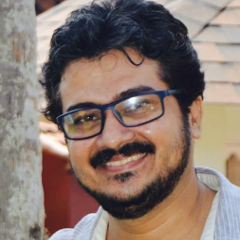What does Modi 2.0 mean for Kerala?

Mail This Article
Prime minister Narendra Modi's visit to Kerala provided fodder for a round of black humour in his party's local unit, licking the wounds from the drubbing it received in the state in the just-concluded general election. After visiting the Lord Krishna Temple at Guruvayur, Modi went straight to a BJP meeting christened, 'Abhinandan Sabha,' which ironically translates to "congratulatory forum."
Now who to congratulate? Of course Modi deserved applause for leading the party to a resounding victory at the national level but the organisation and its allies failed miserably to expand their footprint in Kerala.
Yet Modi chose Kerala to attend his first public meeting after the election. (He had gone to visit the Tirupati temple in Andhra as well but there was no public meeting.) Evidently Modi has not taken his eyes off Kerala just because his party remains a distant second runner-up in the state. At least the state leaders of the party likes to believe so.
The ruling Left Democratic Front (LDF) and the opposition United Democratic Front (UDF) have reasons to worry in Modi's second coming as the prime minister. What does a stronger Modi mean for the state. The CPI(M), which leads the ruling front, is bracing itself to deal with the new Union home minister, Amit Shah, the strongman who replaced Rajnath Singh. The BJP chief has convened a meeting of state party presidents and organisation secretaries in Delhi to reveal his game plan in the new scenario.
The Sangh Parivar that includes BJP's parent organisation and allied entities has assessed that secular-minded voters across communal divides came together to ensure that the BJP did not win a single seat in Kerala. The trend was evident in Thiruvananthapuram, Pathanamthitta and Thrissur, the three seats where the BJP pinned its hopes on. Polling percentage spiked in all three constituencies and that swell was not caused by BJP supporters.

BJP sympathisers have voted for it like they did in 2014. It was the other camp that was consolidated with more determination. In Thiruvananthapuram, BJP's Kummanam Rajasekharan could not expect the secular votes that O Rajagopal managed to mop up in 2014. The party's vote share fell by 1 per cent.
In Pathanamthitta, BJP's K Surendran did not muster even half of the Hindu votes. Actor-turned-politician Suresh Gopi failed to strike a chord with the influential minority communities in Thrissur.
Any party would need to gather at least 3.5 lakh votes in each of the constituencies in Kerala in a triangular fight. This is an impossibility without minority support. The BJP had admitted the fact when it went on appeasing the Christians in Thiruvananthapuram. However, the Christian voters from the coastal areas swayed to the side of the Congress and elected Shashi Tharoor.
The BJP's game plan to build bridges to the Christians in Pathanamthitta through former Union Minister Alphons Kannanthanam and allies P C Thomas and P C George turned out dud. Kannanthanam, Thomas and George could not draw votes from their home turfs to the BJP candidate. The failure must have caused Kannanthanam a second chance in the Modi ministry.
All was not lost for the BJP. The party managed to poll 32 lakh votes across the Kerala, a significant jump from the 18 lakhs in the previous general election but only a marginal rise of 3 lakh votes from the assembly election of 2016. If the party won more than 15 per cent votes in only four constituencies in 2014, it breached the mark in seven constituencies this time. The party won 20 per cent votes in five of them.
Yet the party suffered a dent in its vote base in Kasaragod. The party managed to eat into the vote share of both the dominating fronts in Thrissur, where its vote share jumped to 17 per cent, Attingal (14 per cent) and Alappuzha (13 per cent). The BJP is especially proud of making inroads into Left bastions. Party leaders still expect Kerala to come around, like Tripura, where the party managed to gain power with 49.03 votes, and Bengal, where it finished second with 40.25 votes.
The BJP leadership faced criticism from wannabe candidates for allotting both Scheduled Castes-reserved seats to smaller ally Bharat Dharma Jana Sena. The move, they alleged, distanced the party from dalit voters. The leadership, however, has its goals set. The target group is Christians. The BJP central leadership made it a point to invite four bishops to Modi's swearing-in ceremony.
UPA received its strongest support from Kerala, a state ruled by rival Left Democratic Front. The BJP has a tough task trying to expand its base in one of the last states where it is not a force to reckon with. The stage is set for an invasive campaign and resistance.


